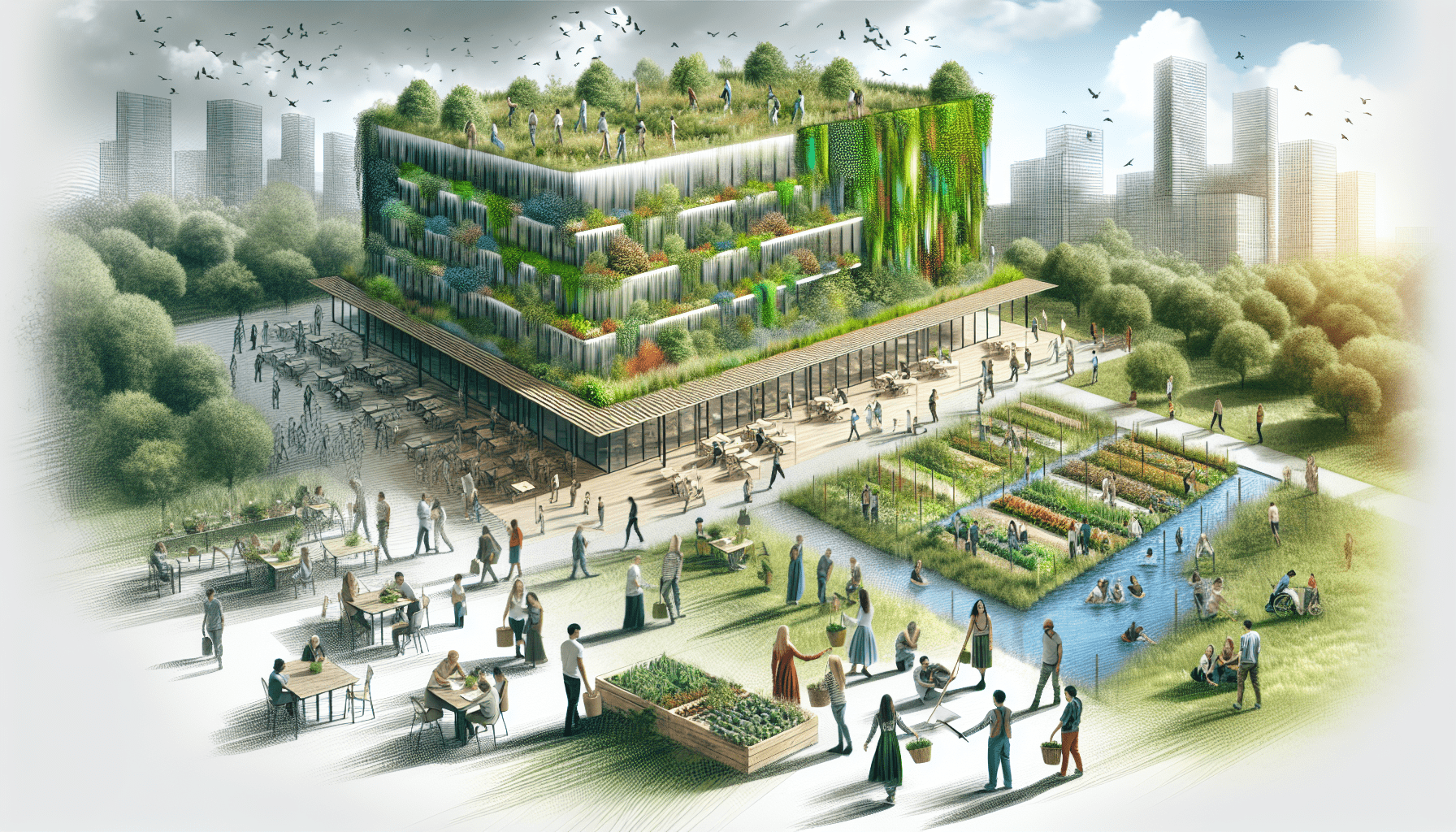In our journey towards building a more sustainable world, the role of community engagement in sustainable architecture cannot be overstated. By involving local residents, stakeholders, and future occupants in the design and implementation process, we ensure that the solutions we create are not only environmentally friendly but also socially inclusive and culturally relevant. Our collective efforts in embracing diverse perspectives lead to innovative, resilient, and adaptable architectural projects that truly meet the needs of the community. With each project, we grow closer to fostering environments that are both livable and sustainable for generations to come. Have you ever wondered what the tangible impact of community engagement is on the journey towards sustainable architecture? As we navigate through an era that demands greater responsibility towards our environment, understanding the role of community engagement becomes increasingly essential. Our discussion today will help us explore this vital element in the realm of sustainable architecture.

Introduction to Sustainable Architecture
Sustainable architecture is much more than a buzzword; it’s a field dedicated to minimizing the environmental impact of buildings through efficient and conscious design. The goal is to create spaces that not only serve human needs but do so in a way that’s considerate of the ecological footprint. By implementing energy-efficient systems, using recycled materials, and integrating natural elements, sustainable architecture paves the way to an eco-friendly future.
Bringing communities into this equation is a step that we can’t afford to overlook. When communities come together to influence design and functionality, the results are usually more tailored, functional, and culturally relevant. But what exactly is community engagement, and why is it indispensable in sustainable architecture?
What is Community Engagement?
Community engagement involves the proactive participation of local residents in the decision-making process. It gives community members a voice and ensures their needs and preferences are considered. From initial planning stages to ongoing maintenance, this engagement can take many forms, including workshops, surveys, and public forums.
Benefits of Community Engagement
Community engagement offers numerous advantages. By involving the community, architects and planners can ensure that the structures they create are not only sustainable but also socially and culturally appropriate. This participatory approach enhances social cohesion and helps generate local pride and ownership.
Forms of Community Engagement
Community engagement can manifest in multitudes of ways, depending on factors such as the scale of the project and the community’s unique requirements. Here are some common forms:
| Form | Description |
|---|---|
| Surveys | Short questionnaires to gather input from residents. |
| Workshops | Group sessions focused on collective problem-solving and brainstorming. |
| Public Forums | Open meetings where ideas and concerns are openly discussed. |
| Focus Groups | Small, diverse groups discussing specific issues or aspects of the project. |
| Participatory Design | Involving community members directly in the design process. |

The Role of Community Engagement in Sustainable Architecture
Identification of Needs and Priorities
One of the most crucial reasons for involving the community is to accurately identify local needs and priorities. Various demographic groups within a community may have different requirements and expectations from a building project. By engaging with the community, architects can tailor their designs to be more inclusive and functional.
Cultural Sensitivity
Sustainable architecture is not just about minimizing environmental impact but also about reflecting the cultural identity of its community. Community engagement ensures that local traditions, values, and aesthetics are respected and incorporated into the design, making the final product culturally enriching and harmonious with its surroundings.
Enhancing Social Cohesion
Involving community members in the design and decision-making process fosters a sense of unity and collective responsibility. It can transform a building project from just another municipal endeavor into a shared community milestone, enhancing social cohesion and local identity.
Empowerment and Ownership
When community members contribute to the development of a project, they feel a sense of ownership and pride. This empowerment can lead to better care and maintenance of the infrastructure. Additionally, communities that feel invested are generally more willing to support, protect, and sustain the project in the long term.
Strategies for Effective Community Engagement
Early Involvement
The earlier we involve the community in the project, the better. Initial stages of project planning are ideal for gathering input and aligning the objectives of architects, planners, and community members. Early involvement helps in building trust and setting realistic expectations.
Transparent Communication
Effective communication is the cornerstone of successful community engagement. All parties involved must maintain transparency regarding goals, constraints, and progress. This allows for better collaboration and reduces mistrust.
Utilization of Local Knowledge
Communities hold valuable knowledge about their locale, including environmental conditions and social dynamics. Leveraging this information can lead to more practical and contextually appropriate solutions.
Inclusivity
It is vital to ensure that all voices within the community are heard, especially marginalized and underrepresented groups. Diverse perspectives contribute to a more equitable and comprehensive design.
Feedback Mechanisms
Ongoing projects should incorporate mechanisms for continuous feedback. Regular updates and opportunities for the community to provide input ensure that the project remains aligned with local expectations and needs.

Real-World Examples
The High Line, New York City
The High Line is an exemplary project showcasing the power of community engagement. Originally an unused railway track, it has been transformed into a public park thanks to a massive outpouring of community support and collaboration. The input from local residents was instrumental in shaping the final design, making it a treasured urban space.
Vauban, Freiburg, Germany
Vauban is a sustainable neighborhood in Freiburg, Germany, where community engagement played a crucial role. Local residents participated from the planning phase to construction, focusing on eco-friendly living and social inclusion. Today, Vauban stands as a model for sustainable living, featuring energy-efficient homes and communal spaces designed by and for its residents.
BedZED, London, UK
The BedZED (Beddington Zero Energy Development) project in London emphasizes sustainability and energy efficiency. Community members were actively involved in the planning process, ensuring that the neighborhood meets both ecological and social needs. Features such as green roofs, solar panels, and shared community spaces were added based on resident feedback.
Challenges in Community Engagement
Time and Costs
One of the primary challenges of community engagement is the additional time and financial resources it requires. Organizing workshops, conducting surveys, and holding public forums can be resource-intensive.
Diverse Opinions
Different community members might have conflicting views, making it challenging to reach a consensus. Facilitating a dialogue that respects diverse opinions while aiming for common ground is a skill that project leaders must develop.
Managing Expectations
Communities may have high expectations that are not always feasible given budgetary, technical, or regulatory constraints. Clear communication is essential to set realistic expectations and avoid future disappointments.

The Future of Community Engagement in Sustainable Architecture
Technological Integration
With advances in technology, new tools are emerging to facilitate community engagement. Digital platforms and social media allow for broader participation, making it easier to gather input and disseminate information.
Policy Support
Governments and institutions are increasingly recognizing the significance of community engagement in urban planning and sustainable architecture. Policy support can provide the necessary framework and incentives for effective community involvement.
Educational Initiatives
Raising awareness and educating both architects and community members about the benefits of engagement is crucial. Educational initiatives can equip stakeholders with the knowledge and skills needed for effective collaboration.
Conclusion
Community engagement is more than a box to check off in the process of sustainable architecture; it is a foundational element that can significantly enhance project outcomes. By prioritizing early involvement, transparent communication, and inclusivity, we can create spaces that are environmentally sustainable, socially cohesive, and culturally resonant.
As we look towards the future, it becomes evident that successful sustainable architecture will increasingly rely on the active and meaningful participation of communities. By doing so, we pave the way for a more inclusive, responsive, and sustainable built environment.
So, what is the role of community engagement in sustainable architecture? Quite simply, it is to make our shared spaces better for everyone involved, now and for generations to come. We’re excited about this collaborative journey and look forward to seeing more projects that exemplify these ideals. Let’s engage, evolve, and build a sustainable future together.